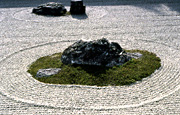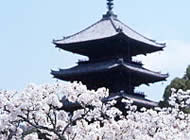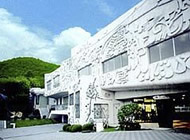Walking the Kinukake-no-michi Trail in the foothills of Mt. Kinugasa (Kinukake-no-michi, Kyoto)

Mt. Kinugasa is also known as Mt. Kinukake, literally meaning “draped with silk”, because its slopes were covered in white silk to create a snow-capped look at the wishes of Japan’s 59th Emperor, Uda, who desired to see a snowy landscape in the middle of summer. Winding through the foothills of this Mt. Kinugasa is a roughly 2.5 km long path known as the Kinukake-no-michi. It starts from Kinkaku-ji Temple that symbolizes the Kitayama culture and served the Muromachi General Yoshimitsu Ashikaga as a hiding place during war, passes by Ryuan-ji Temple famous for its rock garden that expresses the Zen mindset and arrives at Ninna-ji Temple in Omuro, which once served as the residence for the Emperor Uda. This is an excellent area for walking and enjoying temples, shrines, galleries, museums and more.
| By train |
|---|
| Take City Bus Nos. 101 or 201 from JR/Kintetsu Kyoto Station and get off at Kinkakuji-michi. Take City Bus Nos. 12 or 59 from Keihan Sanjo Station or Sanjo Keihan Subway Station and get off at Kinkakuji-mae. |
 |
 |
- 1.JR/Kintetsu Kyoto Station

- (a municipal bus)

- 2.Kinkaku-ji Temple
- Once the villa of the Muromachi General Yoshimitsu Ashikaga,

- 3.Insho-Domoto Museum of Fine Arts
- This museum puts works by Insho-Domoto, renown Japanese artists, member of the Japan Art Academy and recipient of the Order of Cultural Merit from the Emperor of Japan, on a chronological display.

- 4.Toji-in Temple
- This temple is known as the family temple of the Ashikaga Clan because it houses wooden statues of 15 generations of Ashikaga generals.

- 5.Ryoan-ji Temple
- This well-known Zen temple is famous for its rock garden.

- 6.Ninna-ji Temple
- Built by the Emperor Uda, this where he came to live once retired.

- 7.Keifuku Electric Railroad Omuro Station


